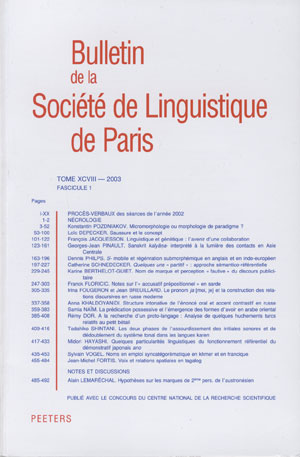 previous article in this issue previous article in this issue | next article in this issue  |

Preview first page |
Document Details : Title: Nouvelles perspectives diachroniques et synchroniques sur l'analogie Author(s): BEN HAMAD, Leïla Journal: Bulletin de la Société de Linguistique de Paris Volume: 118 Issue: 1 Date: 2023 Pages: 27-50 DOI: 10.2143/BSL.118.1.3292778 Abstract : Nous proposons de reconsidérer le processus d’analogie dans son rapport à l’évolution de la langue. Notre objectif est de saisir sa dynamicité complexe, de mettre en évidence ses spécificités, ses contours et ses frontières et de mieux en évaluer le statut épistémologique. Notre optique, tant diachronique que synchronique, est axée sur l’hétérogénéité des définitions et leur empan variable. Nous traitons, d’abord, du terme analogie pris au sens large, indépendamment de toute considération théorique et se situant à l’articulation du (méta)linguistique et du non-linguistique. Nous essayons ensuite de faire le point sur le concept qui réfère techniquement à la langue (ou aux langues) d’une manière explicite en tant que principe d’organisation et, plus particulièrement, en tant que mécanisme d’évolution. Notre propos n’est pas d’expliciter le rapport entre la pérennité d’un mot et les renversements de son sémantisme, en fonction de sa fortune grammaticale et de sa propension annexionniste. Nous ne prétendons pas, non plus, faire une épistémologie exhaustive d’un concept fluide, qui ne peut être assujetti à des règles globales. Nous tenterons une petite esquisse, minimalement suffisante pour situer l’analogie dans la mouvance des processus de changement linguistique. We propose to reconsider the analogy process in its relation to the evolution of the language. Our objective is to grasp its complex dynamicity, to highlight its specificities, its contours, and its borders and to better assess its epistemological status. Our approach, both diachronic and synchronic, focuses on the heterogeneity of definitions and their variable span. We deal, first, with the term analogy, taken in the broad sense, independently of any theoretical consideration and situated at the articulation of the (meta)linguistic and the non-linguistic, as all the abbreviations 'par anal.' of dictionaries. We then try to take stock of the concept that technically refers to language or languages in an explicit way as a principle of organization and, more particularly, as a mechanism of evolution. Our purpose is not to explain the relationship between the durability of a word and the reversals of its semantics, according to its grammatical fortune and its annexationist propensity. Nor do we claim to make an exhaustive epistemology of a fluid concept, which cannot be subject to global rules. We will try a small sketch, minimally sufficient to situate the analogy in the movement of the processes of linguistic change. Wir schlagen vor, den Prozess der Analogie in seinem Verhältnis zur Entwicklung der Sprache zu überdenken. Unser Ziel ist es, seine komplexe Dynamik zu erfassen, seine Besonderheiten, Konturen und Grenzen hervorzuheben und den erkenntnistheoretischen Status besser zu bewerten. Unsere Sicht, sowohl diachronisch als auch synchron, konzentriert sich auf die Heterogenität der Definitionen und ihre variablen Spanne. Zunächst befassen wir uns mit dem Begriff Analogie im weiteren Sinne, unabhängig von jeder theoretischen Betrachtung und bezogen auf die Artikulation des (Meta)Linguistischen und Nicht-Linguistischen, wie alle Abkürzungen 'anal.' zeigen der Wörterbücher. Wir versuchen dann, einen Überblick über das Konzept zu geben, das sich technisch explizit auf die Sprache oder Sprachen als Organisationsprinzip und insbesondere als Mechanismus der Evolution bezieht. Unser Ziel ist es nicht, die Beziehung zwischen der Dauerhaftigkeit eines Wortes und den Umkehrungen seiner Semantik nach seinem grammatischen Reichtum und seiner annexionistischen Neigung zu erklären. Wir behaupten auch nicht, eine umfassende Epistemologie eines fließenden Konzepts zu machen, das nicht globalen Regeln unterworfen werden kann. Wir werden eine kleine Skizze versuchen, die minimal genug ist, um die Analogie in die Bewegung der Prozesse des sprachlichen Wandels einzuordnen. |
|


